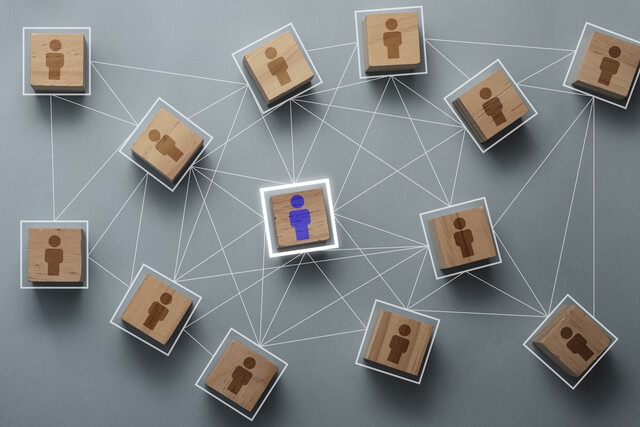When it comes to team building, most people understand that it is not enough to just throw a bunch of people together and call it a team. While this might meet the definition of a team, it is unlikely for any group of people, no matter how individually talented and gifted they are, to be able to work cohesively as a unified team. The fact is that great teams are made, not born. Proper guidance is important, both on an individual level (like any form of management), but also within the context of the larger, full group. Because teamwork is so critical to the success of a wide range of endeavors, and the development of each team so complex, it is vital that those in management positions invest the time and effort necessary to learn how to develop a team properly.
Depending on any given individual's situation, what type of team you wish to build may be tremendously different from the team someone else is working to develop. For some, the team they want to build is an athletic one; from peewee sports to professional leagues, the best coaches understand that it is not enough merely to put together a bunch of gifted athletes, those athletes have to learn how to operate as a cohesive team. For others, teamwork may be geared towards working together to achieve the most sales or some other business activity designed to net the most income for the business (or members of the team). For some people, working as a team means many people performing the same tasks or type of tasks using team spirit and established methods to achieve success. Other teams might alternatively rely on the individual strengths of each team member, building a team that works towards the same goal but with each individual taking on a different role. Thankfully, successful team building often uses the same tactics and psychological design for one type of team as any other type; team building is built upon psychological and sociological theories and methods. While the specific activities a team undertakes may differ wildly, the elements of successful team building stay much the same.
Types of teams
Most people have heard the story of how Ford Motor Company revolutionized manufacturing by developing the first known moving assembly line. Prior to the industrial revolution, most products were handcrafted, from start to finish, by a single person. Obviously, this resulted in limited production and restricted employment opportunities as not everyone was equally able to produce completed projects from start to finish. However, this does not mean there were not still teams; many manufacturers would have a number of employees producing the same objects or items at the same time; instead, these workers operated simultaneously but through teamwork were still able to identify and utilize the best methods, the cheapest suppliers, the best materials, and so on. With a moving assembly line, teams could produce more products in the same period and employ a wider range of people as they would only have to perform one or two select tasks rather than complete the entire project from start to finish. It is worth noting that this technique has limited usefulness, depending on the activities of the team involved.
It is imperative for successful team building that you have established what type of team you are hoping to build. While this may sound obvious, the reality is that what works best may not always be the norm or what you assume you need. Whether you manage a team of 3 or 30,000, it is a good idea to review periodically whether you are using the best type of team for your goals and strategy.
Independent teams
Independent teams typically involve scenarios where each individual member of the team acts or performs complete projects individually but their performance still affects or influences, to varying degrees, the rest of the team. This typically occurs in one of two ways:
Independent members perform the same tasks but the success or failure of the entire team can still hinge upon the success or failure of each independent member. For example, a bowling team might compete against another bowling team and will frequently determine a winner based on the sum total of the scores of each member of the team. Team A consists of four players who scored 140, 173, 195, and 145 for a total of 653 points. Members of Team B, alternatively, scored 92, 160, 197, and 179 for a total of 628 points. Team members played as an individual, with each of them performing the same activity in approximately the same period. However, the entirety of team B lost because one member scored so low that the rest of the team's efforts, including having the highest individual score, were not enough to win. Although this represents an individual composition of a team, the success of the team nevertheless depends upon each member's actions and is thus, consequently, an independent team.
Alternatively, there are completely independent teams where the success (or failure) of one member does not necessarily determine or dictate the success or failure of other members. For example, imagine a school wide spelling bee for third graders. Each third grade teacher works with their class to study the words, practice spelling the words together, and similar shared activities. In this way, each class represents a team who work to encourage each other, share ideas about ways to remember spelling, and so on. When the day of the spelling bee arrives, only one student is going to win. The student who spells the most words correctly would still win even if every other member of their classroom were unable to spell a single word. In this way, these students are considered completely independent team members as they work together as a team but perform independently.
Interdependent teams
When many of us think of a team, we most frequently imagine an interdependent team. In an interdependent team, the success of each member is, to some degree, reliant upon the success of other team members. To distinguish this from independent teams that share the same end result, interdependent teams frequently allow for different team members to perform different activities (the extent to which may vary). For example, a football team is a perfect example of an interdependent style team. No matter how talented a player may be, he or she cannot win on their own. Moreover, while there are utility players, most members have some special position; different team members perform different tasks.
The right type of team for you
If you take the time to assess what your needs are when it comes to your team, there are a few questions that will be pivotal in your decision making, and how will I define success? For the activities I need performed, what level of specialization is needed? What are my goals for this team? What is my ultimate goal? Who else shares this type of goal? What are my obligations to the teams I am on myself? Setting clear, realistic, and measurable goals for your team will be the single most important task you undertake when it comes to team building and achieving success.
Hierarchy of Needs
Understanding how a team can be developed and managed first requires an understanding of the psychological dynamics of the concept of teamwork. Although any group of people working towards a common interest or goal might be considered a team, this is not entirely accurate when it really comes to building a strong and cohesive team unit. Part of the difference between being a member of a group and a member of a team depends upon each team member developing a psychological response to the team environment. After all, most people appreciate that society exists for a reason; social interaction is craved and needed for the psychological well being of the vast majority of humans.
Many people are familiar with Maslow's Hierarchy of Needs, a psychological theory proposed by Abraham Maslow in the 1940s. The theory was further developed and expanded through the ongoing work of Maslow as well as others who came after him. To this day, it is considered one of the best theories of basic human psychological (and physiological) needs. In essence, Maslow developed different levels of need that worked from the most basic needs (such as food, water, sleep, and so on) to more complex needs such as feeling safe, friendship, family relationships, self- esteem, creativity, and far, far more. Within this hierarchy lie many aspects that are the basis for the psychological understanding of teamwork.
The fourth level of the hierarchy of needs is known as theesteem level. While people are generally aware of the importance of self-esteem in our psychological development, many people are not always as aware of how critical it is to be held in esteem by others, especially peers. The respect of others as well as a sense of achievement is incredibly important from a psychological perspective. Workplace psychology (also known as organizational psychology) as well as social psychology has well established just how important these issues are to fostering a productive and safe working environment. When coworkers have different positions and are not expected to act as a team, it is very common to find some employees that have no idea what their coworker actually does, even when their own job is dependent upon these unknown activities of their coworkers. When people do not understand the activities or expertise of the people with whom they work, it is difficult to create a sense of security.
It is even more difficult to create a sense of appreciation on the part of each employee for the tasks undertaken by the other employees. When this is the case, it may be virtually impossible for an employee to feel a tremendous amount of respect for their peers and similarly, to feel much respect directed towards themselves on behalf of their peers. Likewise, self-esteem, confidence, and a sense of achievement are all likely to stem, to some degree, from the work that someone does. While doing a good job may be able to foster some level of these elements, it is difficult for them to be as fully fleshed out, as they could be if the others in their work environment are unaware of their achievements. Creating a team gives employees the opportunity to prove, both to themselves and to their peers, that they are capable and competent. As that occurs more regularly, confidence and respect are bolstered and employees become more productive as they have more of their emotional and psychological needs met.
























